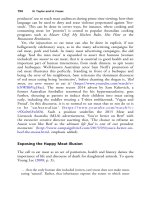The palgrave international handbook of a 484
Bạn đang xem bản rút gọn của tài liệu. Xem và tải ngay bản đầy đủ của tài liệu tại đây (39.7 KB, 1 trang )
486
R. Hediger
Japan, an idea took shape to train attack dogs for use on Pacific islands.
Instrumental to this effort, writes Lemish, was Walter B. Pandre, who
advocated this project and then worked to execute it. Pandre, however,
was difficult for the military and for the dogs. Lemish writes, ‘Pandre, as
part of the training, used electric shocks and bullwhips and even tied some
dogs behind horses and dragged them along the beach or had them fight for
food in the sand along the beaches’ (1996, p. 56). While Pandre was
criticized for the brutality of his methods, his presence helps to reveal
again the fundamental problem of training dogs to perform wartime roles.
As they become weaponized to perform tasks humans desire of them, they
also often become dangerous, at least temporarily. This reality is exemplified,
for instance, in the successful dog program of the U.S. military in Vietnam.
Dogs there had to be treated carefully and often muzzled so that they did not
overstep their prescribed roles. Burnam, a dog handler for the U.S. in the
Vietnam War, calls the dogs ‘lethal weapons’, even as he extolls their effectiveness and his and other handlers’ love for the animals (2000, p. 75).
Still, the example of Pandre offers one more insight: the dogs themselves find ways to resist the training regimes according to their own
desires. Their agency is proved by the dogs’ unpredictability in many
cases, and by the fact that Pandre specifically was unable to train the dogs
to function the way he wanted them to. Ultimately, it was Pandre himself
whom the military would reject and even declare ‘potentially dangerous’
(Lemish 1996, p. 57).
Not all dog trainers in war efforts were of Pandre’s disposition, though.
As Frankel writes in Foreign policy (2014), British Lt. Col. Edwin
Hautenville Richardson was a prime force in the twentieth-century
British effort to make dogs effective in the military. Dogs’ participation
certainly led them to experience brutal injuries and other forms of abusive
trauma, but Frankel notes that Richardson sought to improve the effectiveness of the dogs by underscoring the power and value of the affection
between human and dog. I have referred to this paradox as the weaponization of love—in war, the natural affection between canines and humans
ultimately functions as a weapon.
But, Frankel explains, Richardson’s affection for dogs was genuine, and it
was displayed in his training methods: ‘there was never to be any cruelty or
abuse used in training’ (2014, p. 91). In 1920, Frankel notes, Richardson
published a book about training British war dogs, and his methods were well
ahead of his time. His ‘progressive attitude toward dogs’ and his ‘compassionate treatment’ of them ‘are the models for dog handling today’ (2014, p. 91).
For Frankel, Richardson’s









